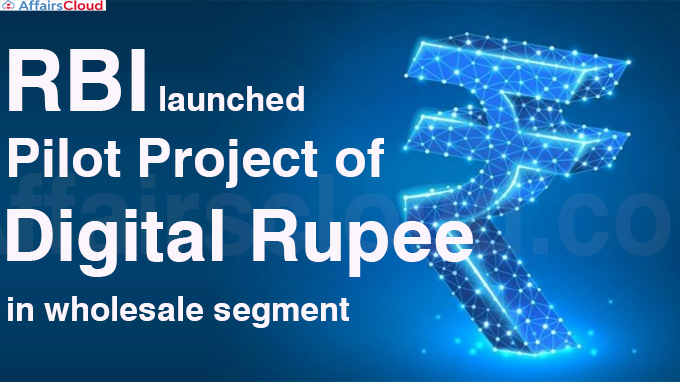
- The first pilot in the Digital Rupee – Retail segment (e₹-R) is set to debut in a month in chosen regions with limited user groups comprising customers and merchants.
Significance
- With CBDC, India is expected to make remarkable progress in the world’s rapidly advancing adoption of digital currencies.
- India is regarded as an early adopter of technology due to the widespread adoption of UPI and QR-based payments.
What is Digital Rupee?
A Central Bank Digital Currency (CBDC) or Digital Rupee is a digital version of currency notes issued by a central bank.
- It is considered as a form of electronic money that may be used in contactless transactions.
The Indian CBDC, which will be known as “(e₹)”, is a digital version of the Rupee and may be exchanged one-for-one for fiat currency.
NOTE: Finance Minister Nirmala Sitharaman announced the introduction of digital currency by the RBI in India in the Union Budget 2022–23.
CBDC Can Be Classified into Two Types:
- Retail (CBDC-R): Retail CBDC would be potentially available for use by all.
- Wholesale (CBDC-W): Wholesale CBDC is designed for restricted access to select financial institutions.
Key Points:
i.The RBI has designated 9 banks to participate in the digital rupee wholesale (e₹-W) pilot project.
- The nine banks are State Bank of India (SBI), Bank of Baroda (BoB), Union Bank of India (UBI), HDFC Bank, ICICI Bank, Kotak Mahindra Bank, Yes Bank, IDFC First Bank, and HSBC.
ii.The adoption of e₹-W is expected to enhance the efficiency of the interbank market and lower transaction costs.
iii.India is among the first significant economies to begin a wholesale CBDC pilot, even though there have been few CBDC test cases globally in a User Acceptance Testing (UAT) environment.
Advantages of Digital Currency
i.A digital currency will not only lower transaction costs but also make it simpler for governments to access all transactions taking place within authorised networks.
ii.The government will be able to create a framework for better budgeting and economic planning for the future as every transaction in the nation will be scrutinised under the relevant laws.
iii.In comparison to physical (real) notes, the lifespan of a digital currency will be indefinite.
iv.Digital currency cannot be torn, burned, or physically damaged, nor can it be lost.
Difference Between Digital Rupee & Cryptocurrency
i.A cryptocurrency is a decentralized digital asset and a medium of exchange based on blockchain technology. (Example: Bitcoin and Ethereum).
- However, it has mostly been questionable owing to its decentralised nature, which means that it operates without any intermediary such as banks, financial institutions, or central authority.
ii.On the other hand, the CBDC or Digital Rupee (e₹) issued by the RBI will function as government-backed legal money in digital form.
Recent Related News:
As per the Chainalysis, ‘The 2022 Global Crypto Adoption Index: Emerging Markets Lead in Grassroots Adoption, China Remains Active Despite Ban, and Crypto Fundamentals Appear Healthy’, Vietnam is ranked first in cryptocurrency adoption for the second consecutive year with an overall index ranking of 1. India stood at 4th with an index score of 0.663.
About Reserve Bank of India (RBI):
Governor – Shaktikanta Das
Established –1935
Headquarters – Mumbai, Maharashtra